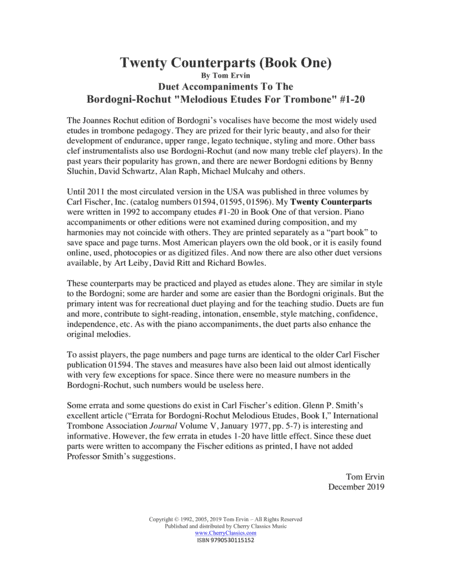Trombone Solo - Level 3 - Digital Download SKU: A0.811087 Composed by Tom Ervin. Arranged by Marco Bordogni. Classical,Instructional,Opera,Romantic Period. Individual part. 26 pages. Gordon Cherry #5009439. Published by Gordon Cherry (A0.811087). The Rochut editions of Bordogni’s vocalises have become the most widly used etudes in American trombone pedigogy. They are prized for their lyric beauty, and also for their development of endurance, upper range, legato technique, styling and more. Other bass clef instrumentalists use Rochut. These Twenty Counterparts may be practiced and played as etudes alone. They are similar in style to the Bordogni; some are harder and some are easier than the Bordogni originals. But the primary intent was for recreational duet playing and for the trombone studio. Duets are fun and more, contributing to sightreading, intonation, ensemble, style-matching, confidence, independence, etc. As with the piano accompaniments, the duet parts also enhance the original melodies. Read what these famous trombonists have to say about this new contribution to the trombone literature …indisputably one of the most invaluable additions to appear in a very long time. Understanding lyricism is much easier when hearing this second voice. Joseph Alessi, Principal Trombone, New York Philharmonic …fantastic and beautiful. What a great idea! They will give the student a wonderful sense of music-making. Henry Charles Smith, Arizona State University …absolutely ingenious….they capture the essential character of each piece and cleverly expand and enhance the original material. Can be ‘stand alone’ material in its own right. I have already used them successfully on trombone, euphonium, and tuba. Loren Marsteller, Los Angeles An enjoyable new way to play the old favorites. Perform them with friends; record one part and play the other; play them alone…a great idea. Ralph Sauer, Principal Trombone Los Angeles Philharmonic A great book and a great idea! Really valuable; I am using it in my teaching. Jay Friedman, Principal Trombone, Chicago Symphony Orchestra Excellent studies, challenging in all registers, rewarding to play. Ned Meredith, formerly San Francisco Symphony Orchestra A very insightful and fresh approach to the trombone’s most important collection of etudes…destined to become a standard in the trombone literature. An absolute must! Michael Davis, jazz recording artist, New York City The unexpected harmonic progressions are a delight. They work great for euphoniums and for trombone and tuba R. Winston Morris, Tennessee Technological University …similar to the Rochut yet contains challenging rhythmic independence and contrast, increasing the value of ensemble experience. As an aid to duet performance, the measure, staff and page format is arranged the same as Rochut’s Fischer edition. Glenn P. Smith, Professor Emeritus University of Michigan A fine addition to the lyrical literature Charles Vernon, Bass Trombone Chicago Symphony Orchestra They’re not only enjoyable to play, but add some ‘zip’, harmonically, melodically, and rhythmically, to the original melodies. Buddy Baker University of Northern Colorado Compositionally, very interesting, not just a duet in thirds…stylistically appropriate…a great way to begin a lesson. Vern Kagarice, University of North Texas An outstanding idea, very valuable Keith Brown, Indiana University I enjoy the book with my students and then also change parts Carsten Svanberg, Danish National Symphony Orchestra Bravo! They serve a great purpose, very musical and playable. Will become a part of the standard trombone repertoire in a very short time…already part of mine. Jiggs Whigham, Professor of Trombone and Jazz, Cologne Germany
